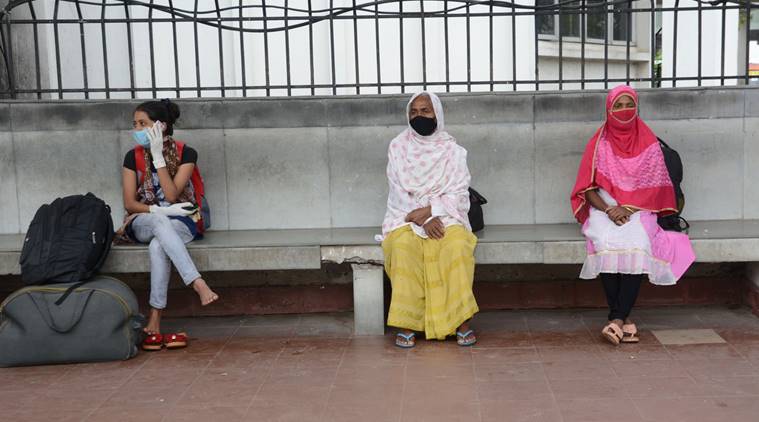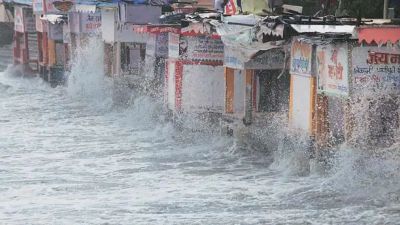- India
- International
How Assam is holding out against Covid-19
Early tracing of infection, extensive testing and strict quarantine backed by social security measures and community involvement have helped the state battle the pandemic
 Women wait for a bus after getting a pass from district administration to go to their home in an Assam State Transport Corporation vehicle (ASTC) during the nationwide lockdown in the wake of coronavirus pandemic in Guwahati. (Express photo: Dasarath Deka)
Women wait for a bus after getting a pass from district administration to go to their home in an Assam State Transport Corporation vehicle (ASTC) during the nationwide lockdown in the wake of coronavirus pandemic in Guwahati. (Express photo: Dasarath Deka)
Written by Swapneel Paul
As India continues to fight its greatest health crisis ever, various models of pandemic management have come to the fore. Amongst them, the Assam Model has largely been successful in containing the burden of infections so far, despite the state having limited resources at its disposal. This has been possible due to the multidimensional and inter-sectoral approach adopted by the state government along with the support of the people of Assam. Follow coronavirus pandemic LIVE updates
The first COVID-19 case was reported in Assam on March 31, a week into the national lockdown. And the number of confirmed cases on May 24, 2020, two months into lockdown, stood at just 392, when many other states started reporting more than thousand cases per day. This was possible due to the efforts made towards contact tracing and isolation of primary contacts during the critical phase. This helped in stopping the virus from exploding in the community in the initial stages like what happened in Italy.
The number of infections started to soar in Assam from around May 25 with new positive cases reaching three digits. Before that, the average number of new infections per day was around 20. This sudden surge coincides with the influx of large number of people who had been stranded in other states, many of whom were carrying the virus. Despite this steep rise in positive cases post May 25, the recovery rate of Assam as on June 19, stands at about 57 per cent, which is higher than the average national recovery rate. More interestingly, the death rate in Assam is just 0.18 per cent, which is among the lowest in the world.
Opinion | How Wuhan controlled COVID-19
Taking a cue from successful models around the world, Assam embarked on an endeavour of “testing of all” who come to Assam. This has helped in reducing the spread of infection and also increased the testing rate in Assam by many folds. Data suggests that it has even surpassed Kerala, a state known for its excellence in healthcare, in the number of samples tested on May 25. Till June 19, Assam has tested 2,58,797 samples, leaving behind more populous states like Odisha and Haryana. This feat could be achieved because of the impetus given towards creating more and more test labs and organising zonal screening centres with swab collection facilities. In Guwahati, swab collection counters have been created in hotels to facilitate the migrants who opt for paid quarantine in such hotels.

Along with universal testing, mandatory institutional quarantine has been another hallmark of the Assam Model. District administrations were ordered to create the COVID Care Centres (CCC) to be used as quarantine facilities. Schools, colleges and community centres were converted into CCCs. Thousands of beds and toilets were installed within days to cater to the influx. For the migrants with higher vulnerability, like old people and pregnant women, hotels were requisitioned by the district administration so that separate rooms may be provided to them. Additionally, migrants who could afford staying in hotels were given the option of paid quarantine facility. Measures like these ensured that the incoming travellers do not sneak out of the quarantine until they tested negative.
It has, however, been observed that certain symptoms take time to manifest and there are instances when people tested positive even days or weeks after they had been tested negative. To address this problem of “late detection”, Assam proposed “home containment”. Here the person, once discharged from institutional quarantine after testing negative, has to remain in home quarantine along with other members of the household, for a period of 14 days in total including both institutional and home quarantine combined. During this period of home containment, the government provided rations to families depending on their size.
During the lockdown, the economic difficulties faced by people were taken care of, to a great extent. General relief comprising of food grains were given multiple times to the poorer households. Additionally, the government also delivered Rs 1,000 to the families, which are economically not well off and are not covered under the National Food Security Act, 2013. The Panchayati Raj Institutions and urban local bodies were given the responsibility, starting from selection of the beneficiaries to the disbursement of monetary assistance to proper maintenance of APR etc.
Opinion | Covid has exposed appalling weaknesses in our societies but soon other problems will take priority
Besides, Rs 2,000 monetary assistance was also given to more than 3.5 lakh people of Assam stranded outside the state under the Assam Cares Programme. This initiative greatly helped the stranded people to sail through the economic hurdles. It also helped in reducing the number of persons coming back to Assam and hence reduced the burden of migrants. Financial assistance was also provided to Assamese patients stranded in other states, suffering from various critical illness. All these steps reduced the suffering of common people and helped in checking the outbreak.
The Infectious Disease Surveillance Programme (IDSP) team supported by police and district administration has done a tremendous job so far in contact-tracing and door-to-door screening and surveillance under the Assam Community Surveillance Programme. A first of its kind, the Targeted Surveillance Programme in Assam is worth mentioning. Under this programme, 50,000 samples will be tested in a span of 10 days. These samples will be randomly taken from amongst the frontline warriors like people employed in truck-parking lots and unloading bays, receptionists in hotels which are used as quarantine centres, policemen etc. Family members of the people in home quarantine would also be randomly tested in this programme. This programme is expected to generate a relevant set of data to gauge the extent of infection in the community, which would be helpful for strategising the future course of action.
The measures discussed above have largely been successful so far due to the wide participation and great support from the people of Assam. Community organisations have been roped in to help in the implementation of COVID-19 regulations related to wearing of masks, coughing etiquette, maintaining social distance etc. More than 15,000 volunteers have registered in the “Protirodhi Bandhu Programme” in which they spread awareness about COVID-19 amongst people, help people get rid of the mental stress arising due to COVID 19 and in certain cases, also help in contact tracing. The village level organisations are also fighting tirelessly with the authorities to help the state fight the crisis.
A few battles have been won but the war is far from over. At this stage it would be very premature to celebrate and show any kind of complacency for whatever success that has been achieved till now. There is no scope for error as it might prove to be costly in times to come. If Assam keeps going with the same momentum in its fight against COVID-19, there is little doubt that the war will be won sooner than later and the state would present a model of pandemic management worth emulating.
The writer is an IAS officer posted as Assistant Commissioner, Nagaon district, Assam. Views are personal
EXPRESS OPINION
More Explained
May 04: Latest News
- 01
- 02
- 03
- 04
- 05








































